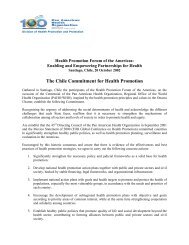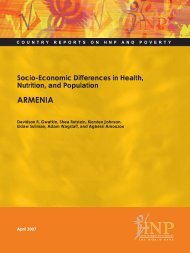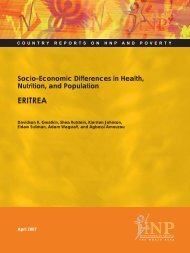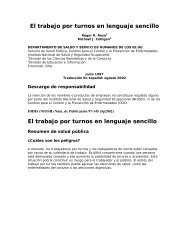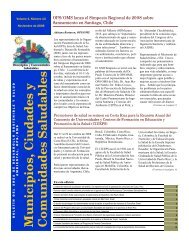Guidelines for drinking-water quality. Volume 1 - BVSDE
Guidelines for drinking-water quality. Volume 1 - BVSDE
Guidelines for drinking-water quality. Volume 1 - BVSDE
You also want an ePaper? Increase the reach of your titles
YUMPU automatically turns print PDFs into web optimized ePapers that Google loves.
on the basis of occupational exposure and inhalation studies in laboratory animals. There are no<br />
adequate studies by which to judge whether it is carcinogenic by oral exposure.<br />
Beryllium has been shown to interact with DNA and cause gene mutations, chromosomal<br />
aberrations, and sister chromatid exchange in cultured mammalian somatic cells, although it has<br />
not been shown to be mutagenic in bacterial test systems.<br />
There are no suitable oral data on which to base a toxicologically supportable guideline value.<br />
However, the very low concentrations of beryllium normally found in <strong>drinking</strong>-<strong>water</strong> seem unlikely<br />
to pose a hazard to consumers.<br />
Boron<br />
Elemental boron is used principally in composite structural materials, and boron compounds are<br />
used in some detergents and industrial processes. Boron compounds are released into <strong>water</strong><br />
from industrial and domestic effluents. Boron is usually present in <strong>drinking</strong>-<strong>water</strong> at<br />
concentrations of below 1 mg/litre, but some higher levels have been found as a result of<br />
naturally occurring boron. The total daily intake of boron is estimated to be between 1 and 5 mg.<br />
When administered as borate or boric acid, boron is rapidly and almost completely absorbed from<br />
the gastrointestinal tract. Boron excretion occurs mainly through the kidney.<br />
Long-term exposure of humans to boron compounds leads to mild gastrointestinal irritation. In<br />
short- and long-term animal studies and in reproductive studies with rats, testicular atrophy has<br />
been observed. Boric acid and borates have not been shown to be mutagenic in various in vitro<br />
test systems. No increase in tumour incidences have been observed in long-term carcinogenicity<br />
studies in mice and rats.<br />
A TDI of 88 µg/kg of body weight was derived by applying an uncertainty factor of 100 (<strong>for</strong> interand<br />
intraspecies variation) to a NOAEL, <strong>for</strong> testicular atrophy, of 8.8 mg/kg of body weight per<br />
day in a 2-year diet study in dogs. This gives a guideline value <strong>for</strong> boron of 0.3 mg/litre (rounded<br />
figure), allocating 10% of the TDI to <strong>drinking</strong>-<strong>water</strong>. It should be noted, however, that the intake of<br />
boron from food is poorly characterized and that its removal by <strong>drinking</strong>-<strong>water</strong> treatment appears<br />
to be poor.<br />
Cadmium<br />
Cadmium metal is used in the steel industry and in plastics. Cadmium compounds are widely<br />
used in batteries. Cadmium is released to the environment in waste<strong>water</strong>, and diffuse pollution is<br />
caused by contamination from fertilizers and local air pollution. Contamination in <strong>drinking</strong>-<strong>water</strong><br />
may also be caused by impurities in the zinc of galvanized pipes and solders and some metal<br />
fittings, although levels in <strong>drinking</strong>-<strong>water</strong> are usually less than 1 µg/litre. Food is the main source<br />
of daily exposure to cadmium. The daily oral intake is 10-35 µg. Smoking is a significant<br />
additional source of cadmium exposure.<br />
Absorption of cadmium compounds is dependent on the solubility of the compounds. Cadmium<br />
accumulates primarily in the kidneys and has a long biological half-life in humans of 10-35 years.<br />
There is evidence that cadmium is carcinogenic by the inhalation route, and IARC has classified<br />
cadmium and cadmium compounds in Group 2A. However, there is no evidence of<br />
carcinogenicity by the oral route, and no clear evidence <strong>for</strong> the genotoxicity of cadmium.<br />
The kidney is the main target organ <strong>for</strong> cadmium toxicity. The critical cadmium concentration in<br />
the renal cortex that would produce a 10% prevalence of low-molecular-weight proteinuria in the<br />
general population is about 200 mg/kg, and would be reached after a daily dietary intake of about<br />
175 µg per person <strong>for</strong> 50 years.




